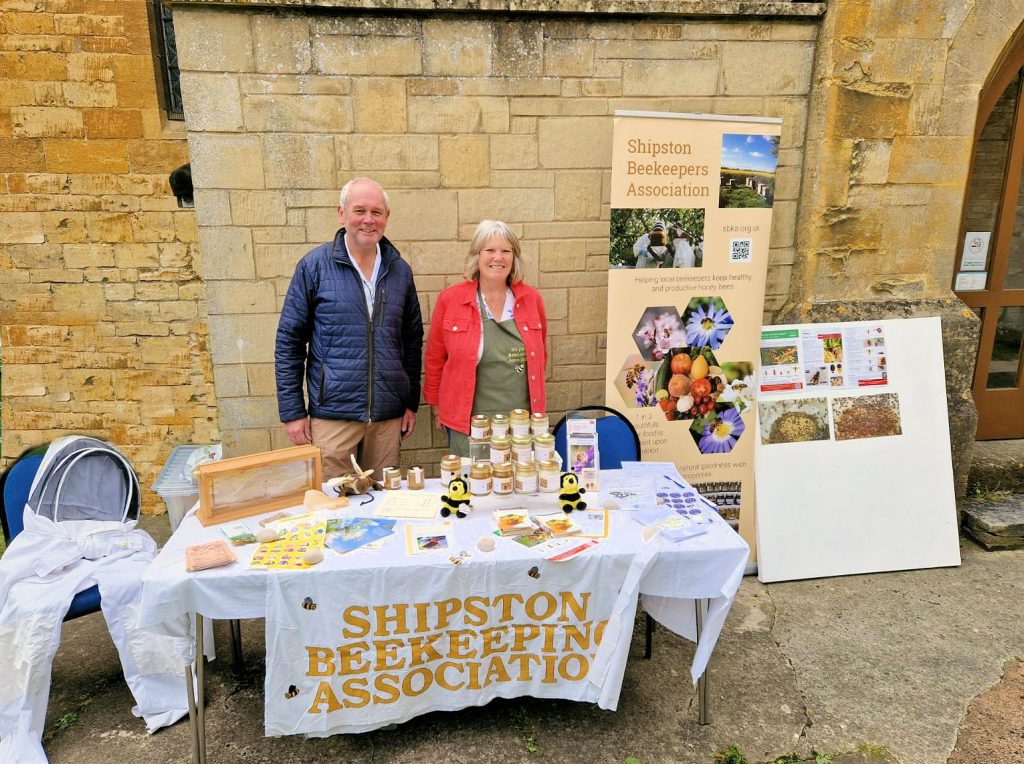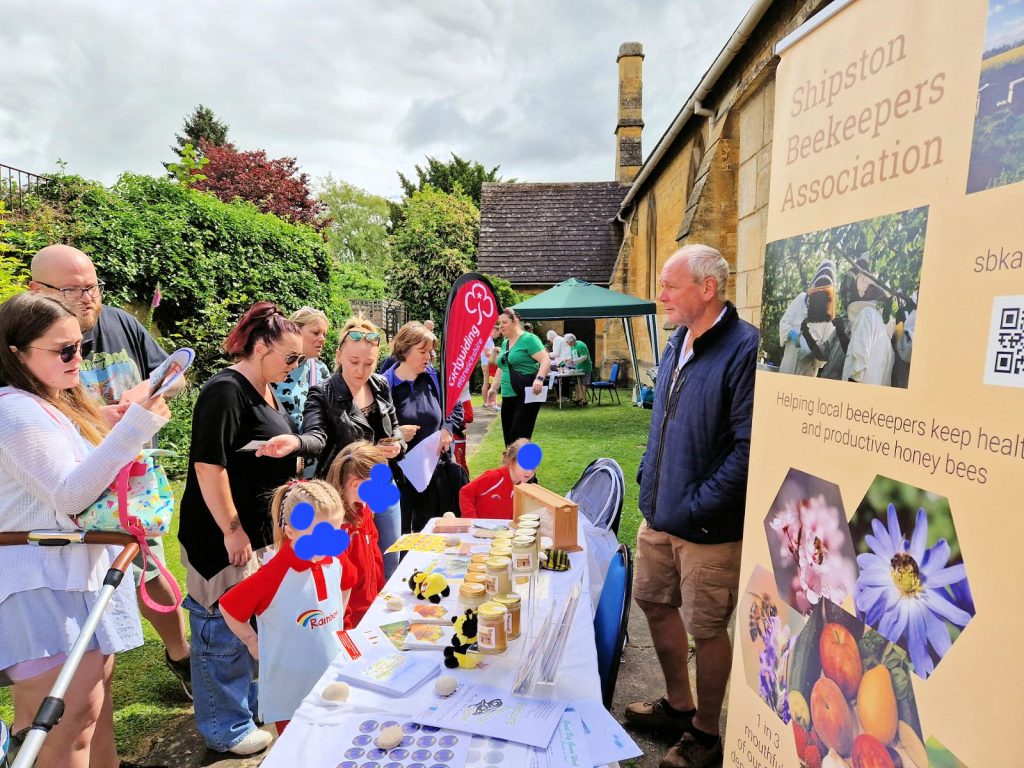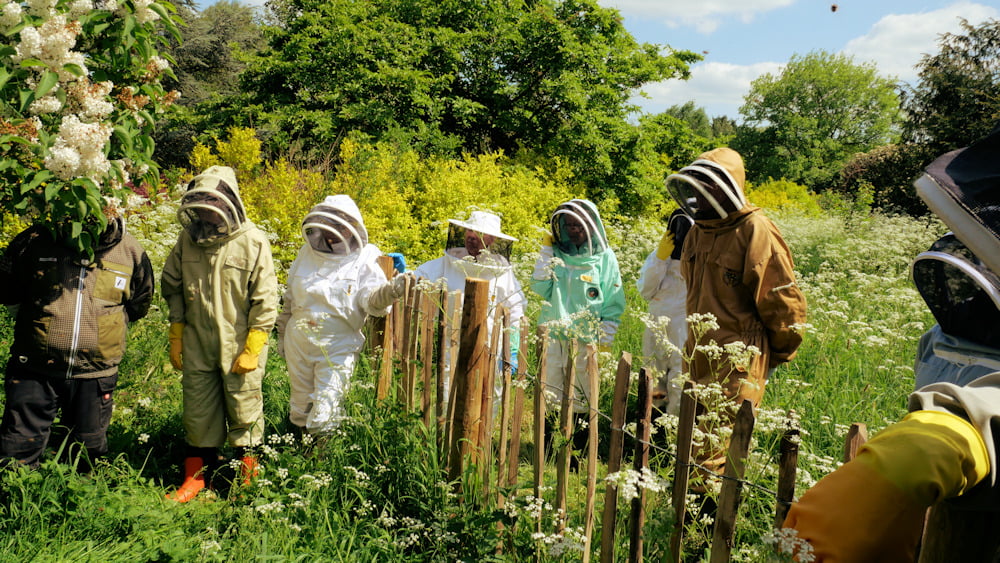Out-Apiary features in Shipston’s Big Green Week
Julia Neal writes:
As members of Shipston Beekeepers, Paul and I participated in helping at Shipston’s first Great Big Green Week Family Trail. This was just one of the events that Stourvale Action For the Environment (SAFE) was organising as part of the UK’s Great Big Green Week celebration.
One of the bases, of which there was six in total, was at St Edmund’s Church. The back of the church yard is a haven for wildlife and it is where Shipston Beekeepers have an ‘out-Apiary’ of the Training Apiary that we set up following a request from the Church a couple of years ago (Ed: see below!).


A slightly longer blog report has been written on this event.
Shipston Apiary Visits – St. Edmund’s Apiary visit 20th May 2023
This was our first apiary visit of 2023 and appropriately, it was in Shipston-on-Stour.
The visit was arranged and co-ordinated by Julia and Paul Neal. They live in Shipston and Paul recently took over looking after the Shipston out-apiary in the garden of St. Edmund’s Church. Our Chair, Ray Pearce, had invited retired Seasonal Bee Inspector Gordon Bull to come along and give us the benefit of his knowledge and experience.
We wrote a detailed report on the Apiary visit as a blog item so rather than repeat it all here, below are a few of photos of the visit to set the scene and a link to the blog report.



The full blog report is at https://sbka.org.uk/shipston-beekeepers-apiary-visits-sat-20th-may-2023/
Stourvale Action for the Environment (SAFE) Week – Talk on the bees at St. Edmund’s Church, 30th September 2022
With our hive settling into a routine of life in a graveyard (!) our partners at the Church, Hilary and Paul Kelly, contacted me in connection with their work with SAFE. They had organised a week of free activities in the last week of September ranging from bike rides, talks on swifts and recycling, garden and wildlife visits and litter picking expeditions.
Hilary asked me to host a talk on the introduction of an apiary at St Edmunds which took place on 30th September in quite inclement weather in the churchyard and quickly moved into the church with tea and biscuits. The weather definitely affected attendence but the group were very supportive and enthusiastic about the project as I explained the timeline of Jo collecting the swarm from the Compton Wynyates estate from a feral colony in an Ash tree to its present situation ready and prepared for the winter.
It is our intention to replace the temporary fencing with a more permanent barrier very soon and provide information boards for the interest and education of the visitors as the graveyard is open to the public everyday from 9-5. This was followed by a tasting of honey from my garden hive in Shipston which rounded off the evening.
Please take the opportunity to visit if you find yourselves with a spare moment when next in Shipston and I will keep Shipston members updated via the website with further bits of news as our management of the apiary unfolds.
Graham Newton, St. Edmunds Beekeeper
Beginnings……
Sometime back in 2021 Shipston Beekeepers was contacted by a representative of St. Edmund’s Church, Shipston-on-Stour. They were turning the area behind the church into a wild garden that people could visit and wondered if Shipston Beekeepers would be interested in keeping some bees in the garden.
The Committee immediately saw this as an opportunity to help us fulfil our charitable aims of ‘promote and further the craft of beekeeping and to advance the education of the public in the importance of bees in the environment’, something that had been difficult to do during the Covid lockdowns.
Whilst we identified budget it was clear we could not proceed unless we had a volunteer to look after the bees. Fortunately for us Graham Newton volunteered to not only be the beekeeper but to work with St. Edmunds Church to get the apiary up and running. In this he was assisted by David Blower MB, regarding all issues bees, and Steve Woolf on health and safety issues.
We now have one colony on site with space for one more (think swarm control next spring!).
On this page we will chart the progress of the colony through the beekeeping year.






